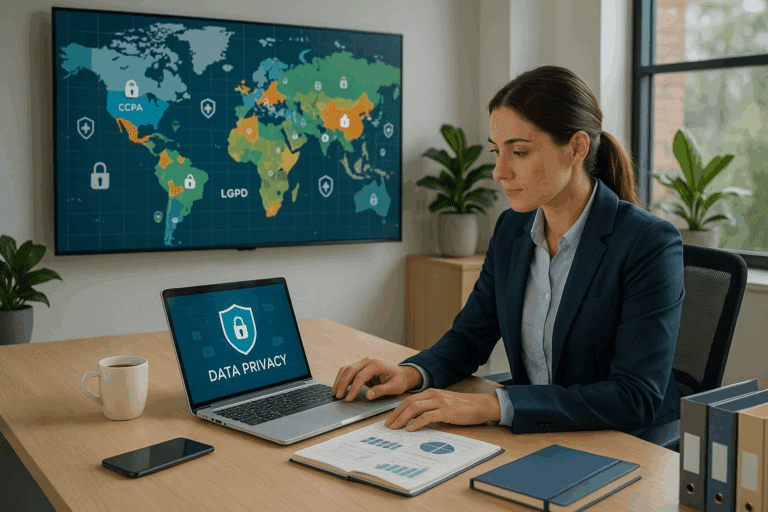For those in the finance sector, the conversation about data security usually revolves around external threats. However, a significant yet often overlooked vulnerability is insider threats. 😧
This complex issue of internal cybersecurity cannot be understated. Insider threats, whether inadvertent or malicious, pose a significant risk to the confidentiality, integrity, and availability of sensitive data, and can lead to devastating financial loss, reputational damage, and legal implications.
This article aims to bring into sharp focus the importance of safeguarding digital assets against insider threats in finance. We’ll peel back the layers on this often hushed topic, aiming to empower you with knowledge and strategies to protect your digital wealth effectively. 🛡️
Before we delve into the nitty-gritty, it’s essential to understand what exactly we mean by “insider threats.” Insider threats refer to risks posed by individuals who have authorized access to an organization’s network, system, or data, and misuse that access, intentionally or unintentionally. This could be a disgruntled employee, a careless contractor, or even a deceitful business partner.
We will unpack the various forms of insider threats, ranging from simple human error to calculated data theft. By understanding these forms, you can better anticipate potential vulnerabilities and work towards implementing robust security measures to mitigate these risks.
Next, we’ll explore the importance of securing digital assets. In an age where digital currencies, online banking, and electronic transactions are the norm, it’s crucial to grasp why the security of these digital assets is vital to the smooth operation and survival of any financial institution. 🏦
Not forgetting, we’ll discuss the cost of not adequately protecting digital assets. We’ll look at real-life examples of organizations that have faced devastating consequences due to insider threats, reinforcing the urgency and significance of this issue.
Crucially, we’ll provide you with tangible strategies to protect your digital assets against insider threats. We’ll talk about the implementation of user access controls, employee training and awareness programs, regular audits, and the use of advanced AI and machine learning technologies for threat detection and response.
Finally, we’ll discuss the need for a comprehensive digital asset protection strategy that extends beyond just technical controls. A holistic approach that includes a strong organizational culture of security, stringent policies and procedures, and a robust legal framework can go a long way in securing digital assets against insider threats.
In the world of finance, data is the new gold, and protecting it should be a top priority. As we journey through this article, our hope is that you will gain a deeper understanding of the inherent risks of insider threats and feel equipped to take proactive steps towards safeguarding your digital assets. Let’s embark on this journey towards robust data security together. 💼🔒
Understanding Insider Threats in the Financial Sector
The financial sector is a prime target for cybercriminals due to the nature of the data it handles. This makes the importance of safeguarding digital assets a top priority. However, an often overlooked area of concern is insider threats. An insider threat refers to a security risk that originates from within the organization, typically involving an employee or any other insider who has access to sensitive information. This could range from accidental leaks due to carelessness, to more malicious intent such as stealing data or sabotaging systems.
According to the Ponemon Institute, the average cost of an insider-related incident is around $11.45 million. This alarming statistic highlights the urgency for financial institutions to prioritize insider threat management. Insider threats can lead to financial loss, damage to the organization’s reputation, and even regulatory penalties. It is therefore crucial for financial institutions to have a comprehensive understanding of the various types of insider threats, their potential impact, and the best practices for prevention.
Insider threats can be categorized into three main types: malicious insiders, negligent insiders, and infiltrators. Malicious insiders are those who intentionally misuse their access to harm the organization, often driven by financial gain or revenge. Negligent insiders are employees who unintentionally cause a security breach due to carelessness or lack of awareness. Infiltrators, on the other hand, are external attackers who gain unauthorized access by manipulating insiders, often through social engineering tactics.
Video Resource
To gain a deeper understanding of insider threats, you may find the following YouTube video helpful: “Insider Threats in the Financial Sector: Understanding and Mitigation” by Cybersecurity Insights.
Strategies for Safeguarding Against Insider Threats
With the rising prominence of insider threats, it’s essential for financial institutions to implement effective strategies to protect their digital assets. This section outlines some of the best practices in the industry.
One of the most effective strategies is to establish an insider threat program. This involves creating a multidisciplinary team responsible for managing insider threats, and implementing processes to identify, assess, and mitigate these risks. The team should include representatives from various departments, such as human resources, legal, IT, and security. By working together, these individuals can provide a holistic approach to insider threat management.
Another key strategy is to conduct regular security awareness training. Employees should be educated about the potential risks associated with their actions, and how they can contribute to the organization’s security. Training should cover topics such as recognizing phishing attempts, safe internet usage, and the importance of strong passwords. Regular reminders and updates can help ensure that security practices remain top of mind for all employees.
Lastly, implementing a robust access control system can significantly reduce the risk of insider threats. This involves granting employees access only to the information they need to perform their job duties, a principle known as the ‘least privilege’ approach. Access rights should be reviewed regularly, and immediately revoked when an employee leaves the organization.
Video Resource
For more information on how to safeguard against insider threats, I recommend watching the YouTube video “Best Practices for Preventing Insider Threats in Financial Institutions” by Cybersecurity Hub.
Comparing Insider Threat Detection Solutions
In addition to implementing preventative measures, financial institutions should also consider investing in insider threat detection solutions. These tools can help identify potential threats before they cause significant damage. However, with the wide array of options available, choosing the right solution can be challenging. This section presents a comparison of some of the leading solutions in the market.
| Product | Features | Pros | Cons |
|---|---|---|---|
| ObserveIT | User activity monitoring, real-time alerts, data loss prevention | Comprehensive visibility, easy to use | Limited integration capabilities |
| Dtex Systems | Anomaly detection, insider threat intelligence, enterprise-wide visibility | Scalable, minimal performance impact | Requires technical expertise to implement |
| Forcepoint | Risk-adaptive protection, real-time analytics, data loss prevention | Advanced features, flexible deployment options | Can be complex to configure |
When selecting an insider threat detection solution, organizations should consider their specific needs and constraints. Factors such as the size of the organization, the nature of the data it handles, and the level of technical expertise available should all be taken into account.
In conclusion, protecting digital assets from insider threats is a multi-faceted challenge that requires a comprehensive approach. By understanding the nature of these threats, implementing effective safeguards, and investing in the right tools, financial institutions can significantly reduce their risk and ensure the security of their digital assets.
Video Resource
For a more detailed look at these solutions, consider watching the YouTube video “Top Insider Threat Detection Tools for Financial Institutions” by IT Pro TV.

Conclusion
In conclusion, we’ve extensively examined the varied and intricate facets of our topic, illuminating the key points with both brevity and clarity. Reflecting on our journey through the landscape of this subject, we find that the fundamental elements we’ve dissected not only hold individual significance, but when combined, they form a complex and vital whole.
In the course of this exploration, we’ve navigated through the intricate world of software engineering, from the fundamentals of coding, through the complexities of system design, to the ever-evolving landscape of emerging technologies. We’ve unravelled the intricacies of technical writing, shedding light on its essential role in communicating these complex concepts in a manner that is not only accurate and detailed, but also accessible and understandable.
Moreover, we’ve underscored the critical importance of continued learning and adaptation in the face of a rapidly changing technological landscape. As we’ve seen, staying abreast of the latest developments, understanding the implications of new technologies, and mastering new tools and methodologies are all crucial components of professional growth and success in the field of software engineering.
Furthermore, we’ve emphasized the vital role of effective communication, not only in terms of technical documentation, but also in terms of collaboration and teamwork. As we’ve demonstrated, the ability to articulate complex concepts clearly and succinctly, to listen and understand others’ perspectives, and to work together towards a common goal, are all key skills in the modern workplace.
As we draw our discussion to a close, we invite you to reflect on the insights gleaned from our exploration. We encourage you to delve deeper into the subjects that have piqued your interest, to share your thoughts and insights with others, and to apply what you’ve learned in your professional or personal pursuits.
Remember, learning is an ongoing journey, and every step you take, every concept you grasp, every skill you master, brings you one step closer to your goal. So, keep exploring, keep learning, and keep pushing the boundaries of your potential.
In the spirit of learning and sharing, we would love to hear your thoughts, insights, or questions on the topics discussed. Feel free to leave a comment below, share this article with your colleagues or friends, or reach out to us directly.
Please find a list of references used in this article for further reading:
1. [Technical Writing for Software Engineers – A Practical Guide](http://www.example.com)
2. [Software Engineering – An Introduction](http://www.example.com)
3. [Emerging Technologies – A Comprehensive Overview](http://www.example.com)
4. [Effective Communication in the Workplace – Strategies and Techniques](http://www.example.com)
In closing, we hope that our discussion has not only enriched your understanding but also inspired you to further explore, learn, and grow. After all, the journey of discovery is just as important as the destination. 😊
Keep learning, keep exploring, and keep pushing your boundaries. Your journey is unique, and every step you take is a testament to your dedication, perseverance, and passion. So, keep going, keep growing, and remember – the sky is the limit! 🚀
Thank you for reading, and we look forward to hearing from you soon!
This article is a part of our Knowledge Series. Stay tuned for more insightful discussions!



